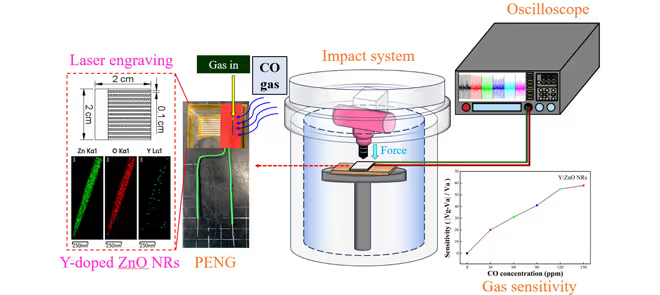High-Sensitivity of Self-Powered Gas Sensors Based on Piezoelectric Nanogenerators With Y-Doped 1-D ZnO Nanostructures
Traditional gas sensors rely on external power sources, which increase their size and limit usability. In contrast, self-powered sensors convert natural mechanical energy, such as tapping and vibration, into electrical energy. This enables the creation of compact devices crucial for industrial safety, particularly for detecting hazardous gases like carbon monoxide (CO).
CO is a prevalent and dangerous gas, underscoring the need for effective detection methods. Zinc oxide, an n-type wide bandgap semiconductor, is a promising material for CO sensing due to its advantageous properties. The hydrothermal route is an efficient technique for fabricating one-dimensional ZnO nanostructures.
This study synthesizes yttrium-doped ZnO nanorod arrays via hydrothermal methods to create a self-powered gas sensor based on a piezoelectric nanogenerator (PENG). Key fabrication steps involve using a 2 × 2 cm indium-tin-oxide (ITO) polyethylene terephthalate (PET) substrate, which is prepared with a silver (Ag) top electrode through radio frequency (RF) magnetron sputtering.
The ZnO nanorod arrays are grown on an ITO/PET substrate, beginning with a 100 nm ZnO seed layer. The growth solution includes zinc nitrate hexahydrate, hexamethylenetetramine, and yttrium nitrate mixed and stirred in deionized water at 95 °C for 3 hours. The PENG device is then assembled by sealing the silver electrode to the Y-doped ZnO nanorod array, which features a gas inlet for detection.
Characterization of yttrium-doped ZnO nanorod arrays employs techniques like field-emission scanning electron microscopy (FE-SEM) for surface structure analysis, X-ray diffraction (XRD) for crystalline properties and photoluminescence (PL) spectroscopy for optical performance.
Results indicate that ZnO NRs have an average diameter of 109 nm and a height of 1.33 µm, while Y:ZnO NRs have a diameter of 180 nm and a height of 1.60 µm. Energy-dispersive X-ray (EDX) analysis shows a Y content of 0.96 at%. PL spectroscopy reveals enhanced green emission in Y:ZnO NRs, suggesting increased surface charge and reduced band gap due to Y ion replacement.
The PENG's electrical performance is assessed by measuring output voltage and current during mechanical impacts in a vacuum chamber. CO gas is introduced at concentrations of 0, 30, 60, 90, 120, and 150 ppm, demonstrating that average output voltage decreases as CO concentration increases. This trend confirms the PENG's potential as a sensitive gas sensor.
Y-doping modifies the surface state and defect density of ZnO, influencing gas adsorption and altering piezoelectric output voltage. Upon exposure to CO, oxygen ions on the ZnO NR surface react, increasing carrier density and decreasing piezoelectric output voltage due to the screening effect of free electrons.
In ambient air, surface vacancies adsorb oxygen molecules, increasing the output voltage. The introduction of CO reduces the depletion layer and enhances the screening effect, leading to decreased output voltage. The increased active sites from Y doping further enhance gas-sensing performance.
The study shows that the developed self-powered gas sensor using Y-doped 1-D ZnO NR arrays exhibits superior sensitivity to CO compared to conventional ZnO PENGs. The self-powered sensors operate effectively at room temperature, offering potential applications in environmental monitoring and industrial safety.




